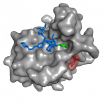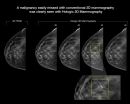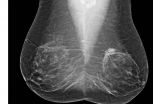Researchers control adhesion of E. coli bacteria
Team from Goethe University Frankfurt and Kiel University have jointly created a synthetic surface
2014-12-02
(Press-News.org) A research team from Kiel University (CAU) and Goethe University Frankfurt has jointly created a synthetic surface on which the adhesion of E. coli bacteria can be controlled. The layer, which is only approximately four nanometres thick, imitates the saccharide coating (glycocalyx) of cells onto which the bacteria adhere such as during an infection. This docking process can be switched on and off using light. This means that the scientists have now made an important step towards understanding the relationship between sugar (carbohydrates) and bacterial infections. Their research results embellish the front page of the latest issue of the renowned journal Angewandte Chemie (Applied Chemistry).
The bond between either cells and other cells or cells and surfaces is vital to organisms, for example in the development of internal organs and tissue. However, these mechanisms are also involved in illness and infections. The E. coli bacteria used in the experiment can cause urinary tract infections, meningitis, sepsis and other severe illnesses. In order to understand and treat these illnesses, researchers need to decipher the molecular processes which allow the bacteria cells to dock onto the healthy host cells.
This often happens by way of proteins, which interact with carbohydrate structures on the surface of the host cell by means of a complex fit principle (simplified: lock-and-key principle). The Kiel/Frankfurt study demonstrates for the first time that the spatial orientation of the carbohydrate structures is crucial to this process. However, in natural glycocalyx, a mere nanometre thick polysaccharide layer covering all cells, the relationships are still too complex to uncover how proteins and carbohydrates identify each other.
In Collaborative Research Center (SFB) 677 'Function by Switching', Professor Thisbe K. Lindhorst, chemist at Kiel University, and her team construct molecules which, when irradiated by light at different wavelengths, operate as biological switches. Together with the working group around the surfaces specialist Professor Andreas Terfort (Frankfurt University), the Lindhorst group has now produced a system with which the orientation of the saccharide docking points, and thus the bonding of E. coli bacteria, can be controlled. To do this, the scientists covered an extremely thin gold surface with a precisely defined saccharide covering, coupled to azobenzene. This is a hydrocarbon containing a nitrogen bridge and operating as a hinge controlled by light. The bonding properties of the saccharide coating can now be switched using this method: if the researchers irradiate their system with light with a wavelength of 365 nanometres, considerably fewer pathogenic bacteria cells can adhere to the synthetic surface. The saccharide molecules turn away from the bacteria, in a sense, and can no longer be recognised. When switched on by 450 nanometre wavelength light waves, on the other hand, the structures reorientate such that the bacteria cells can dock on once again. In this way, E. coli adhesion can be controlled.
'By employing a layer system on a solid surface, in combination with a photo-hinge, the complex dynamics of a real glycocalyx can be reduced to the principal processes and thus be better understood', explains Terfort. 'It should be possible to transfer this novel approach to other biological boundary layer systems.'
'Based on our model system, glycocalyx recognition and bonding effects can be precisely defined and investigated from a completely new angle', says Lindhorst. 'If we can learn how to influence glycocalyx in the context of the relationship between health and healing, it will lead to a revolution in medicinal chemistry.'
INFORMATION:
Original publication
Switching of bacterial adhesion to a glycosylated surface by reversible reorientation of the carbohydrate ligand. Theresa Weber, Vijayanand Chandrasekaran, Insa Stamer, Mikkel B. Thygesen, Andreas Terfort and Thisbe K. Lindhorst. Angew. Chem. 48/2014 DOI: 10.1002/ange.201409808 and 10.1002/anie.201409808 (Angew. Chem. Int. Ed.)
Photos and figures are available for download:
http://www.uni-kiel.de/download/pm/2014/2014-395-1.jpg
Caption: Left: E. coli bacteria can dock onto the saccharide molecules of the synthetic glcocalyx using the FimH protein. Right: When irradiated with light at a wavelength of 365 nanometres, the saccharide molecules on the surface bend away and cannot be recognised by the proteins. The bacteria can then no longer dock onto the host cell.
Figure/Copyright: Wiley-VCH Verlag GmbH & Co. KGaA. Reproduced with permission.
http://www.uni-kiel.de/download/pm/2014/2014-395-2.jpg
Caption: Controlled bonding: the adhesion of bacteria onto saccharide molecules on the glycocalyx model can be reversibly controlled by light.
Figure/Copyright: Wiley-VCH Verlag GmbH & Co. KGaA. Reproduced with permission.
http://www.uni-kiel.de/download/pm/2014/2014-395-3.jpg
Caption: Scanning electron micrograph of Escherichia coli, grown in culture and adhered to a cover slip.
Credit: NIAID
http://www.uni-kiel.de/download/pm/2014/2014-395-4.jpg
Caption: Thisbe K. Lindhorst (photo) and her team control the adhesion of E. coli bacteria using switchable saccharide molecules.
Photo/Copyright: Stefan Kolbe
http://www.uni-kiel.de/download/pm/2014/2014-395-5.jpg
Caption: Surfaces specialist Andreas Terfort (photo) from Goethe University Frankfurt
Photo/Copyright: Larissa Zherlitsyna
Contact
Prof. Dr Thisbe K. Lindhorst
Christian-Albrechts-Universität zu Kiel
Otto Diels-Institut für Organische Chemie
Tel.: +49 (0)431 880-2023
E-mail: tklind@oc.uni-kiel.de
Prof. Dr Andreas Terfort
Goethe-Universität Frankfurt
Tel.: +49 (0)69798-29180.
E-mail: aterfort@chemie.uni-frankfurt.de
ELSE PRESS RELEASES FROM THIS DATE:
2014-12-02
This news release is available in German.
The FK506-binding protein 51 (FKBP51) is an established risk factor for stress-related psychiatric disorders such as major depression. Drug discovery for FKBP51 has been hampered by the inability to pharmacologically differentiate against the very similar functional counterplayer FKBP52. Scientists at the Max Planck Institute of Psychiatry in Munich have now developed the first potent and highly selective inhibitor of FKBP51. The so-called SAFit-ligand inhibits FKBP51 enhancing growth of neuronal cell cultures and improving ...
2014-12-02
Molecular clocks -- based on changes in genetic material -- indicate much younger ages for a wide variety of plants found as fossils in southern Argentina than do the solid, geologic dates of those fossils, according to geoscientists who surveyed recent paleobotanical discoveries in Patagonia.
The finding suggests serious biases in molecular clocks, which are heavily used to date many kinds of living things. It also directly refutes a widely-held idea about how most Southern Hemisphere plant and animal groups attained their current distributions.
Geologists date fossils ...
2014-12-02
A team of scientists has revealed how certain harmful bacteria drill into our cells to kill them. Their study shows how bacterial 'nanodrills' assemble themselves on the outer surfaces of our cells, and includes the first movie of how they then punch holes in the cells' outer membranes. The research, published today in the journal eLife, supports the development of new drugs that target this mechanism, which is implicated in serious diseases. The team brings together researchers from UCL, Birkbeck, University of London, the University of Leicester, and Monash University ...
2014-12-02
In the city that never sleeps, it's easy to overlook the insects underfoot. But that doesn't mean they're not working hard. A new study from North Carolina State University shows that insects and other arthropods play a significant role in disposing of garbage on the streets of Manhattan.
"We calculate that the arthropods on medians down the Broadway/West St. corridor alone could consume more than 2,100 pounds of discarded junk food, the equivalent of 60,000 hot dogs, every year - assuming they take a break in the winter," says Dr. Elsa Youngsteadt, a research associate ...
2014-12-02
ARLINGTON HEIGHTS, Ill. (December 2, 2014) - If you are one of the millions of Americans who experiences a severe allergic reaction to food, latex or an insect sting, you should know the first line of defense in combating the reaction is epinephrine. Unfortunately, not all medical personnel know how important epinephrine is in bringing an allergic reaction under control.
According to new guidelines published in the Annals of Allergy, Asthma and Immunology, the scientific publication of the American College of Allergy, Asthma and Immunology (ACAAI), the fast administration ...
2014-12-02
AUSTIN, Texas -- Researchers at The University of Texas at Austin have identified a network of genes that appear to work together in determining alcohol dependence. The findings, which could lead to future treatments and therapies for alcoholics and possibly help doctors screen for alcoholism, are being published this week in the journal Molecular Psychiatry.
By comparing patterns of genetic code from the brain tissue of alcoholics and nonalcoholics, the researchers discovered a particular set of genes co-expressed together in the individuals who had consumed the most ...
2014-12-02
CHICAGO - According to a new long-term study, diabetic patients with even mild coronary artery disease face the same relative risk for a heart attack or other major adverse heart events as diabetics with serious single-vessel obstructive disease. Results of the study were presented today at the annual meeting of the Radiological Society of North America (RSNA).
Researchers at the University of British Columbia and St. Paul's Hospital in Vancouver analyzed data from the Coronary CT Angiography Evaluation For Clinical Outcomes: An International Multicenter (CONFIRM) Registry, ...
2014-12-02
CHICAGO - A major new study being presented at the annual meeting of the Radiological Society of North America (RSNA) has found that digital breast tomosynthesis, also known as 3-D mammography, has the potential to significantly increase the cancer detection rate in mammography screening of women with dense breasts.
Breasts are considered dense if they have a lot of fibrous or glandular tissue but not much fatty tissue. Research has shown that dense breasts are more likely to develop cancer, a problem compounded by the fact that cancer in dense breasts can be difficult ...
2014-12-02
CHICAGO - A study of breast cancers detected with screening mammography found that strong family history and dense breast tissue were commonly absent in women between the ages of 40 and 49 diagnosed with breast cancer. Results of the study were presented today at the annual meeting of the Radiological Society of North America (RSNA).
"Screening recommendations for this age group continue to be debated," said Bonnie N. Joe, M.D., Ph.D., associate professor in residence and chief of women's imaging at University of California, San Francisco (UCSF). "Recent publications ...
2014-12-02
CHICAGO - Patients value direct, independent access to their medical exams, according to a new study presented at the annual meeting of the Radiological Society of North America (RSNA).
Fragmentation of health information among physicians, healthcare institutions or practices, and inefficient exchange of test results can decrease quality of care and contribute to high medical costs. Improving communications and giving patients more control over their care are critical goals of health IT initiatives.
"Easy and timely electronic access to an online unified source of ...
LAST 30 PRESS RELEASES:
[Press-News.org] Researchers control adhesion of E. coli bacteria
Team from Goethe University Frankfurt and Kiel University have jointly created a synthetic surface



